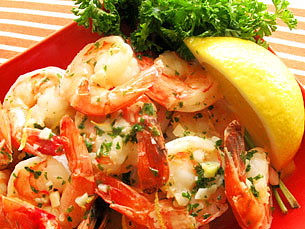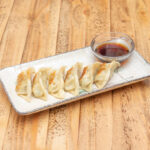Shrimp scampi is a delightful and flavorful dish that has its roots in Italian cuisine. It is a classic Italian-American recipe that has gained popularity worldwide. The dish is known for its succulent shrimp cooked in a luscious garlic and butter sauce, which is further enhanced with hints of lemon and white wine. Shrimp scampi is often served over a bed of pasta or accompanied by crusty bread, allowing you to savor every last drop of the delectable sauce.
The star ingredient, shrimp, is typically peeled and deveined, ensuring a tender and juicy bite. The garlic plays a prominent role in this dish, infusing it with its aromatic essence and creating a savory foundation for the sauce. The combination of butter and olive oil provides richness and depth, while the addition of white wine adds a delightful complexity to the flavor profile. A splash of fresh lemon juice adds a refreshing tang, balancing the richness of the dish.
Shrimp scampi is incredibly versatile, allowing for variations and personal touches. Some recipes include additional ingredients such as red pepper flakes for a touch of heat, chopped parsley for a burst of freshness, or even cherry tomatoes for a burst of color and sweetness. The dish can be prepared quickly, making it an excellent choice for a weeknight dinner or a special occasion.
Whether you’re a seafood lover or simply enjoy indulging in delightful flavors, shrimp scampi is a dish that is sure to satisfy your taste buds. Its combination of succulent shrimp, aromatic garlic, buttery sauce, and zesty accents create a harmonious symphony of flavors that will leave you craving more. So, whether you decide to enjoy it over a plate of pasta or savor it with a piece of crusty bread, shrimp scampi is a culinary delight that is sure to impress.
| Ingredients: | |
| 1 | 1 pound (450g) shrimp, peeled and deveined |
| 2 | 4 tablespoons unsalted butter |
| 3 | 3 tablespoons olive oil |
| 4 | 4 cloves garlic, minced |
| 5 | 1/2 teaspoon red pepper flakes (optional) |
| 6 | 1/4 cup white wine |
| 7 | 2 tablespoons freshly squeezed lemon juice |
| 8 | Salt and pepper, to taste |
| 9 | 2 tablespoons chopped fresh parsley |
| 10 | Cooked pasta or crusty bread, for serving |
Step-by-step cooking instructions of Shrimp Scampi:
Step-1 In a large skillet, melt the butter and olive oil over medium heat.
Step-2 The skillet should now contain the minced garlic and red pepper flakes (if using). The garlic should be sautéed for about a minute until aromatic.
Step-3 Increase the heat to medium-high and add the shrimp to the skillet. Season with salt and pepper. Cook for 2-3 minutes per side until the shrimp turn pink and opaque.
Step-4 Remove the shrimp from the skillet and set aside.
Step-5 Pour the white wine and lemon juice into the skillet, scraping the bottom to deglaze and incorporate any browned bits.
Step-6 Let the sauce simmer for a few minutes until it slightly reduces and thickens.
Step-7 Return the shrimp to the skillet and toss them in the sauce to coat evenly. Cook for an additional minute to heat the shrimp through.
Step-8 Remove from heat and sprinkle chopped parsley over the shrimp scampi.
Step-9 Serve the shrimp scampi over cooked pasta or with crusty bread for dipping.
Step-10 Feel free to adjust the seasoning and garnish according to your taste preferences. Enjoy your homemade shrimp scampi!
Nutritional value of Shrimp Scampi:
Shrimp scampi’s nutritional value can vary depending on the specific recipe and serving size. Here is a general overview of the nutritional components typically found in shrimp scampi:
| 1 | Shrimp: Shrimp is a low-calorie and high-protein seafood option. It is also a good source of essential nutrients such as selenium, vitamin B12, and iodine. Shrimp is low in fat and carbohydrates but contains cholesterol. |
| 2 | Butter and Olive Oil: The butter and olive oil used in shrimp scampi contribute to its rich and flavorful sauce. While they add taste, they are also high in calories and fat. Moderation is key when consuming these ingredients. |
| 3 | Garlic: Garlic adds a distinct flavor to shrimp scampi and also provides potential health benefits. It contains antioxidants and may have antimicrobial properties. |
| 4 | White Wine: The white wine used in shrimp scampi can add depth to the sauce. However, the alcohol content typically evaporates during cooking. It is important to note that if you have specific dietary restrictions or concerns, you can substitute white wine with alternatives like chicken or vegetable broth. |
| 5 | Lemon Juice: Freshly squeezed lemon juice adds a tangy and refreshing taste to shrimp scampi. Lemons are a good source of vitamin C and antioxidants. |
| 6 | Pasta or Bread: If served with pasta or bread, the nutritional value will vary based on the specific type and portion size. Pasta can provide carbohydrates, while bread can contribute to calorie intake. |
Background History of Shrimp Scampi:
The exact origins of shrimp scampi are not well-documented, but it is believed to have emerged as a popular dish in Italian-American cuisine. The word “scampi” originally referred to a type of small lobster found in the Adriatic Sea, but in the United States, it came to refer to a preparation method for shrimp.
The dish likely originated in the coastal regions of Italy, where seafood is abundant and forms an essential part of the culinary traditions. Italian immigrants brought their recipes and culinary techniques to the United States, where shrimp scampi gained popularity and became a staple in Italian-American restaurants.
The traditional preparation of shrimp scampi involves sautéing shrimp in a garlic and butter sauce, often with the addition of olive oil, white wine, and lemon juice. The sauce is usually served over pasta or accompanied by crusty bread, allowing diners to soak up the flavorful sauce.
Over time, variations of shrimp scampi have emerged, incorporating additional ingredients such as red pepper flakes, herbs like parsley or basil, and even cherry tomatoes for added flavor and visual appeal.
Today, shrimp scampi remains a beloved dish in Italian-American cuisine and has also gained popularity in various other parts of the world. It is appreciated for its simple yet flavorful combination of ingredients, showcasing the natural sweetness of shrimp along with the rich and aromatic sauce.
While its exact history may be somewhat elusive, shrimp scampi has undoubtedly become a classic seafood dish that continues to delight food enthusiasts with its delicious flavors and cultural heritage.
| Advantages of Shrimp Scampi | |
| 1 | Rich in Protein: Shrimp, the main ingredient in shrimp scampi, is a great source of high-quality protein. It helps support muscle growth and repair, and provides a feeling of satiety. |
| 2 | Nutrient-Rich: Shrimp is also a good source of essential nutrients such as selenium, vitamin B12, and iodine. These nutrients play important roles in various bodily functions, including metabolism, nerve function, and thyroid health. |
| 3 | Low in Calories: Shrimp scampi can be a relatively low-calorie dish, especially if prepared with portion control and minimal added fats. This makes it suitable for those watching their calorie intake. |
| 4 | Versatile and Customizable: Shrimp scampi is a versatile dish that can be customized to suit individual preferences. You can add vegetables, herbs, or spices to enhance the flavor and nutritional profile. It can be served with a variety of side dishes, such as whole wheat pasta, quinoa, or steamed vegetables. |
| Disadvantages of Shrimp Scampi | |
| 1 | High in Cholesterol: Shrimp contains dietary cholesterol, so individuals with specific dietary restrictions or cholesterol concerns should consume it in moderation. However, it’s important to note that dietary cholesterol has less impact on blood cholesterol levels than was previously thought. |
| 2 | Potential for High Sodium Content: Depending on the recipe and ingredients used, shrimp scampi can be high in sodium. This is primarily due to added salt and ingredients like butter or broth. Individuals with high blood pressure or sodium sensitivity should be mindful of their intake and consider lower-sodium alternatives. |
| 3 | Fat and Calorie Content: Shrimp scampi often includes butter and olive oil, which contribute to its rich flavor. While these ingredients can add taste, they also increase the calorie and fat content of the dish. Portion control and mindful ingredient choices can help mitigate this potential disadvantage. |
| 4 | Allergy Concerns: Shrimp is one of the common food allergens, and individuals with shellfish allergies should avoid shrimp scampi or find suitable alternatives. It’s important to be aware of any potential allergies or dietary restrictions when consuming seafood dishes. |
Compare with Similar meal of Shrimp Scampi:
There are several similar meals to shrimp scampi that you might enjoy. Here are a few options:
| 1 | Lemon Garlic Shrimp: This dish is similar to shrimp scampi but focuses more on the lemon and garlic flavors. It typically involves sautéing shrimp in a tangy lemon and garlic sauce, often with the addition of herbs like parsley or basil. |
| 2 | Garlic Butter Shrimp: In this recipe, shrimp are prepared in a buttery, delicious, and creamy garlic sauce. It is a straightforward but tasty technique that brings out the shrimp’s inherent sweetness. |
| 3 | Cajun Shrimp: If you enjoy a bit of spice, Cajun shrimp is a great choice. It involves seasoning the shrimp with a blend of Cajun spices, such as paprika, cayenne pepper, and garlic powder, and then cooking it to perfection. |
| 4 | Shrimp Stir-Fry: This is a versatile dish where shrimp is quickly cooked with an assortment of colorful vegetables, such as bell peppers, broccoli, and snap peas, in a savory sauce. It can be served over rice or noodles for a satisfying meal. |
| 5 | Coconut Curry Shrimp: For those who enjoy bold and exotic flavors, coconut curry shrimp is a fantastic option. The shrimp is simmered in a creamy coconut curry sauce, infused with aromatic spices and herbs. |
| 6 | Shrimp and Pasta: If you love the combination of shrimp and pasta but want to explore beyond scampi, there are various pasta dishes that feature shrimp as the star ingredient. Examples include shrimp Alfredo, shrimp marinara, or shrimp primavera. |
Mostly questions asked about Shrimp Scampi
1: What is shrimp scampi?
A: Popular Italian-American cuisine known as shrimp scampi comprises shrimp cooked in a delicious butter and garlic sauce.
2: Can I use frozen shrimp for shrimp scampi?
A: For shrimp scampi, you can indeed use frozen shrimp. Just be certain to drain and defrost them before cooking.
3: Can I substitute the white wine in shrimp scampi?
A: Yes, if you prefer not to use white wine, you can substitute it with chicken or vegetable broth.
4: What side dishes go well with shrimp scampi?
A: Shrimp scampi pairs well with side dishes like pasta, steamed vegetables, rice, or a fresh green salad.
5: Can I add vegetables to shrimp scampi?
A: Yes, you can add vegetables like cherry tomatoes, spinach, or bell peppers to shrimp scampi for added flavor and nutrition.
6: Can I make shrimp scampi without wine?
A: Yes, if you prefer not to use wine, you can omit it or replace it with lemon juice or broth for a different flavor profile.
7: Can I use a different type of seafood instead of shrimp?
A: Yes, you can adapt the recipe and use other types of seafood like scallops or lobster in place of shrimp.
8: Is shrimp scampi spicy?
A: Shrimp scampi is not typically spicy, but you can add red pepper flakes or other spicy ingredients if you prefer a bit of heat.
9: Can I make shrimp scampi in advance?
A: It’s best to cook shrimp scampi fresh for the best flavor and texture. However, you can prepare the ingredients in advance and cook it just before serving.
10: Can I make shrimp scampi without butter?
A: While butter adds richness to shrimp scampi, you can make a lighter version by using less butter or substituting it with additional olive oil.







